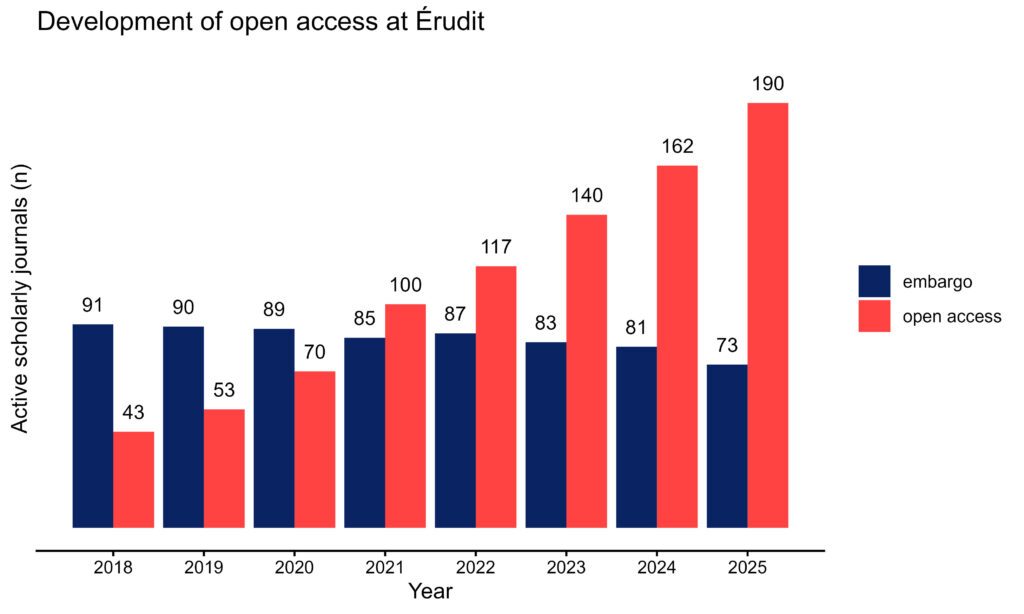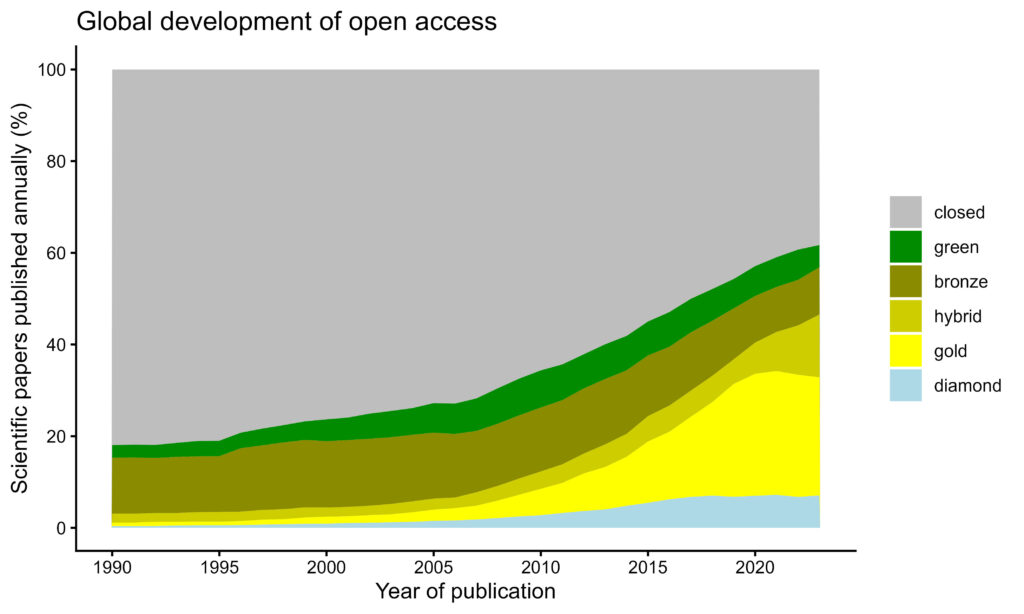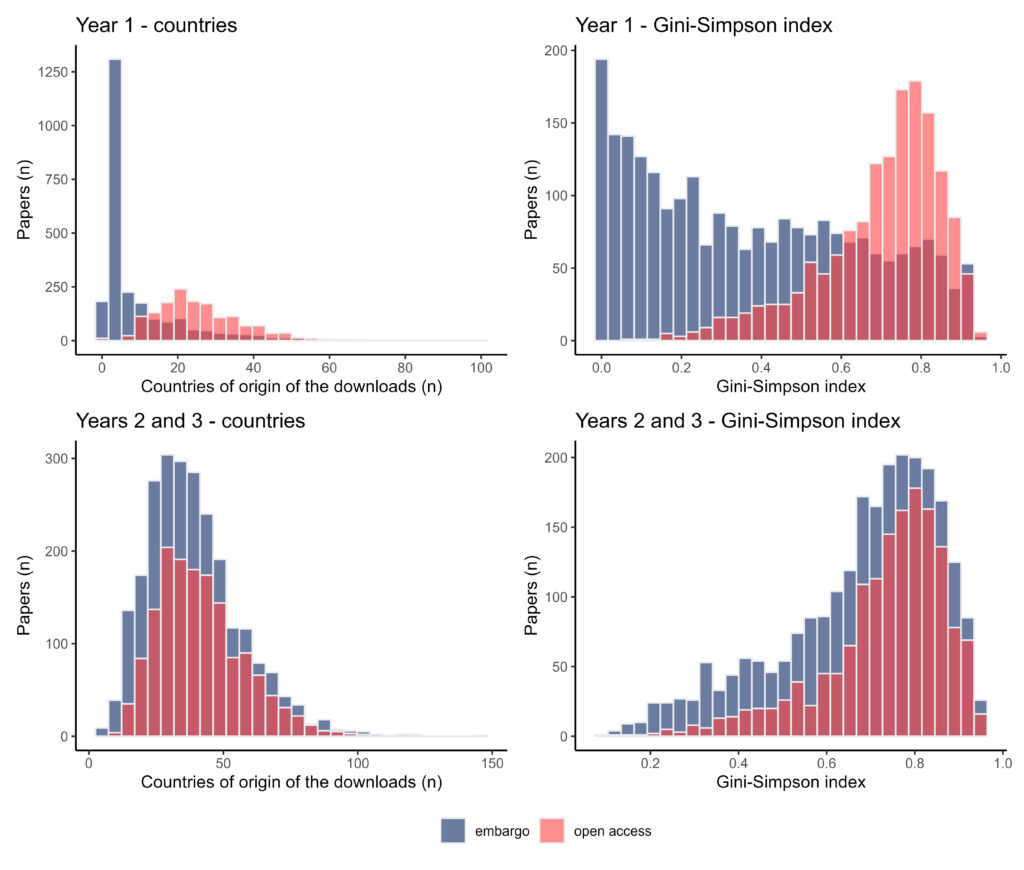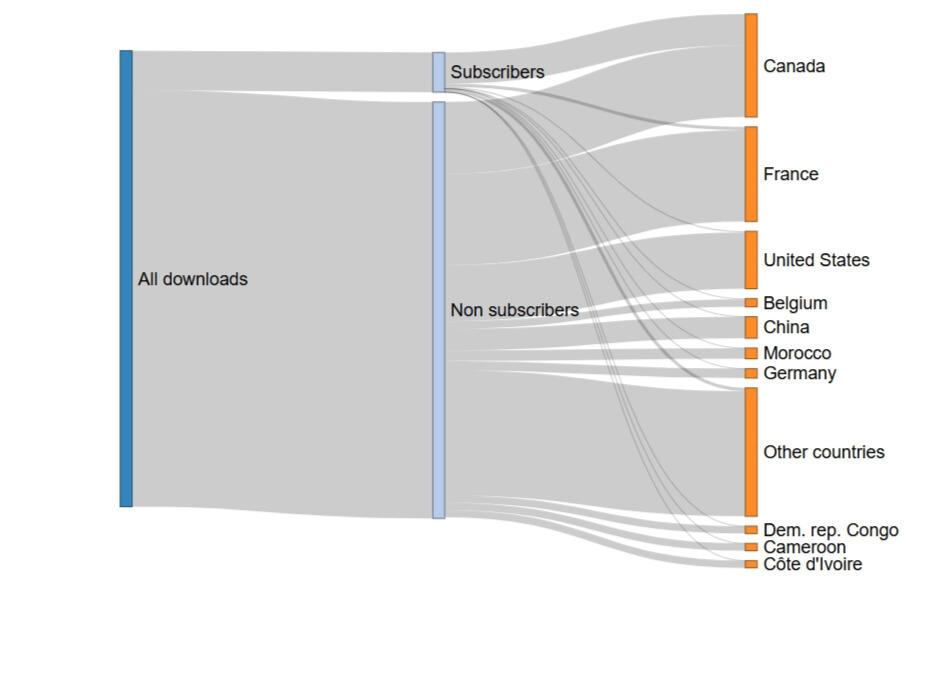
Every scholarly journal’s editorial team has surely, at one point, asked the following question: should we be moving to open access? For readers, the benefits of this type of access are undeniable, but what about for the journals themselves? To measure the impact on journals, we modelled the effect of open access on article views on the Érudit platform, and the results are conclusive: in the first year an article is published, open access increases the number of views by a factor of 3.2.
Written by Simon van Bellen, Senior Research Advisor at Érudit.
The Growth of Open Access
Open access has been an integral part of Érudit since its creation in 1998. Today, two publishing modes coexist on our platform. The dominant model is based on the principle of diamond open access, which makes every article in a journal freely accessible with an open licence, without delay, and at no cost for authors. For close to a decade, the number of journals in open access has grown substantially (Figure 1). The other mode is a “moving wall”: journals impose a subscription to access the content they have published over the last year, while access to older issues is unrestricted. Research and teaching organizations in Canada make up the majority of Érudit’s subscribers, and they provide their communities with access to all the content disseminated on the platform.


Open access has a clear advantage in terms of disseminating knowledge: readers can access new knowledge freely. However, the issue is more complex from the perspective of journals, as adopting open access generally means a loss of subscription revenue, and many journals already operate on tight budgets. Nevertheless, adopting open access does seem to increase a journal’s reach¹. That is the hypothesis at the core of this study.
Different Ways to Increase Reach
Quantifying or even just estimating the reach or impact of a journal is not an easy task, even if several metrics already exist. The relevance of the current metrics—we can think of the Impact Factor (IF)—has been a widely debated question in the scientific literature². Calculated based on citations received by the articles of a particular journal, the IF generally acts as a metric for the usage of a journal by research communities. Citations do not reflect in any way the multiple other forms of impact, such as readership or education for the general public, for students as part of a class, or even for practitioners seeking to improve their working methods.
However, wider use, including in non-academic spheres, could be captured by online viewing trends. Today, about 99% of scholarly content on the Érudit platform can be viewed freely by anyone with Internet access³. Scholarly articles on Érudit are viewed close to 40 million times a year by web users from all around the world.
To get a more accurate idea of the impact of open access on the reach of journals and the articles they publish, we analyzed the numbers of views and the geographic diversity of the readership for close to 4,000 articles. When analyzing a (potential) effect from open access, it is essential to consider other possible factors that might influence usage levels and readership composition. We can mention notably the language of publication, the field, and the research matter, as well as some article characteristics, such as the presence of key words or a (large) bibliography. To carefully identify the individual potential effect of each of these variables on views, we created a statistical model that only includes relevant variables, selected through a step-by-step procedure.
We first identified the variables associated with viewing trends during the first year of dissemination. This sample contained both articles in open access and content that required a subscription to consult. We then analyzed the viewing trends over years 2 to 5 post-dissemination, a period where all articles are freely accessible. Further methodological details are provided at the end of this note.
Impact of Open Access on Number of Views
The analyses on view counts in the first year of dissemination confirm that open access has a decisive effect on views. The final model, which takes account of the effects of all relevant variables, shows that, during the first year of dissemination, open access multiplies the number of views by around 3.2 compared to articles behind a moving wall. This makes the mode of access the main factor influencing the number of views.
When it came to views in subsequent years, we were curious to see if there was a compensating effect. Do articles that become accessible after 12 months “catch up” to articles in open access since the start in terms of views? In theory, such an effect could be explained by readers coming back to Érudit to download content which had previously been unaccessible. However, we did not detect that type of effect: during years 2 to 5 after dissemination, articles published in open access remained more widely viewed than articles that became available with a delay. Five years after publication, immediate open access led to 25% more views than articles published behind a moving wall during its first year.
Open Access and Readership Geographic Diversity
What about the readership’s geographical diversity? For that, we analyzed which countries the subscribed institutions were located in, as well as the countries associated with the IP addresses for non-subscribed web users. First, the analysis only considered the first year of dissemination, comparing open access and access-restricted content. We could then identify that open access led to greater geographical diversity in the readership, with a median of 23 different countries accessing open access content, versus only four countries for restricted content (Figure 3). This result could be explained theoretically by the fact that open access articles are simply viewed more frequently. To compensate for this potential effect, for each article, we also calculated the Gini-Simpson index, a commonly-used diversity measure. The Gini-Simpson index defines in our context, the probability, expressed on a scale of 0 to 1, that two people viewing the same article live in different countries. The calculated indices confirmed that diversity in terms of the geographical origin of views was clearly higher for open access articles, with a median index of 0.74, compared to 0.33 for content published behind a moving wall (Figure 3).
Once the barrier is lifted after 12 months, the geographical diversity of views for “liberated” articles increases noticeably. Over the two years following the removal of the paywall, the median value of the number of countries goes from four to 36, and the median for the Gini-Simpson index, from 0.33 to 0.72. These increases suggest a real potential to widen the readership for these pieces of content. However, still for the second and third year post-dissemination, these values remain lower than those for content in open access at the moment of publication. For this open access content, the median number of countries is 39 and the median for the Gini-Simpson index is 0.77. A statistical test confirmed that articles published in open access have significantly more diversified readerships (Kolmogorov-Smirnov test; p < 0.001).

These results show that open access on Érudit increases the geographical diversity of the readership. This phenomenon is explained notably by the geographic origin of institutions paying for a subscription: more than 30% of subscribed institutions are Canadian, and they represent close to 80% of views by subscribers. However, no less than 91% of views on Érudit came from unsubscribed users (Figure 4), and these views originated from a wide variety of geographic locations: more from France (22%) than from Canada (17%), while 14% came from the United States.

Context for Viewing Trends
What do these results mean? First, it should be mentioned that views are not a perfect metric, as they represent a relatively superficial interaction with the content. A user can view an article without necessarily learning from it, or re-using it, or even reading it. However, it can represent a general interest level for a subject, or, if the reader uses a search engine, the discoverability level of the article in question⁴. Moreover, simply viewing an article, even if the reader is not really interested, can lead to further exploration of the journal in which the article was published or of Érudit in general. An article with solid reach since its publication is a boon for the journal, for example, by supporting its funding, and for the authors, as it allows them to quickly demonstrate their contribution to the field of research, which can be decisive in the context of a competition, a grant application, or a promotion process. International reach, driven by open access, can be an interesting factor for organizations that support national research, such as the Fonds de recherche du Québec and the Social Sciences and Humanities Research Council, as well as for the journals in which it is published. The marked impact of articles published in open access should further motivate these organizations to provide more support for journals transitioning to open access, while trying to maintain financial and organizational viability.
We demonstrated that, in the context of publishing in the fields of the social sciences and the humanities in Canada, open access has a measurable and significant effect on views. This result should encourage more journals to adopt this mode of publication, benefiting authors, national and international readership, and consequently the circulation of new knowledge.
Detailed Methodology
The sample was composed of research articles disseminated on the Érudit platform in 2018 and 2019 and which had not been disseminated elsewhere before 2017. The total number of articles was 3,988. Views were quantified based on the COUNTER R5 standard. We used a generalized negative binomial model to describe the relationship between the various article characteristics and the number of views. This model is particularly well suited to cases where the values of the dependent variable follow a Poisson distribution, which means that there are many lower values and very few higher ones. Beyond access type (open/12-month moving wall), the independent variables include: the journal’s field, the language of publication for the article, the thematic scope of the article (local/national or general), the location of origin of the affiliations (at least one Canadian/international affiliation only), the location of origin of the DOI attribution (Érudit/elsewhere), the type of article processing for dissemination on erudit.org (complete/limited), the presence/absence of a summary, the presence/absence of key words, and the number of references in the bibliography. The model used was chosen based on the Akaike information criterion, and the performance of the model was evaluated by ensuring the homogeneity of the variance and the absence of collinearity between the independent variables.
¹ Huang, C.-K., Neylon, C., Montgomery, L., Hosking, R., Diprose, J. P., Handcock, R. N., & Wilson, K. (2024). “Open access research outputs receive more diverse citations”. Scientometrics, 129(2), 825–845. https://doi.org/10.1007/s11192-023-04894-0
² Gingras, Y. (2014). Les dérives de l’évaluation de la recherche. Du bon usage de la bibliométrie. Paris : Raisons d’agir.
³ In the “openly accessible” content, we include all the content that has been disseminated for over a year on Érudit, as well as the more recent content published in open access journals.
⁴ Discoverability is defined as “the potential for online content to be easily discovered in cyberspace by web users, notably by those that are not specifically looking for this particular content.”
Want to learn more about open access? Check out all the latest open access news from Érudit.